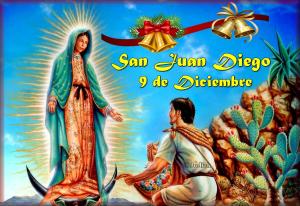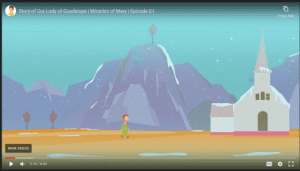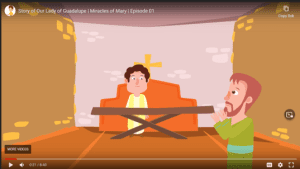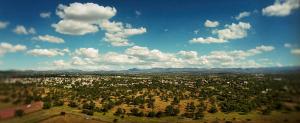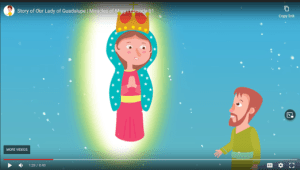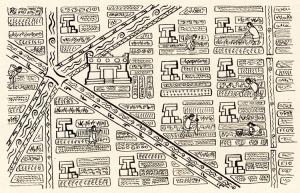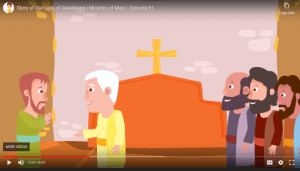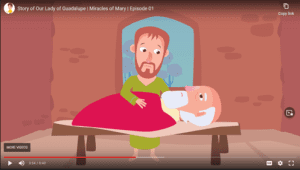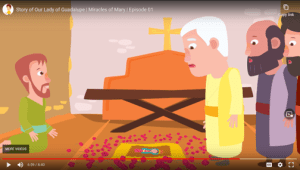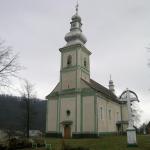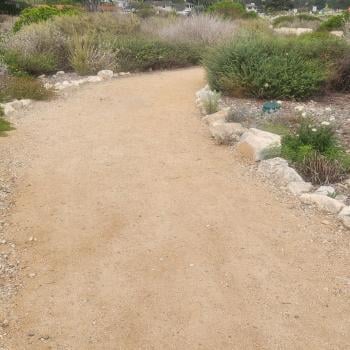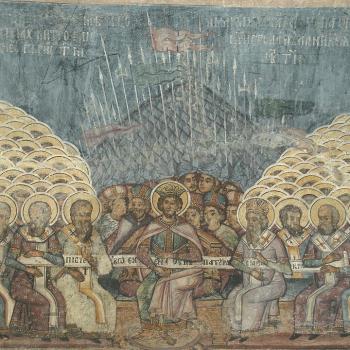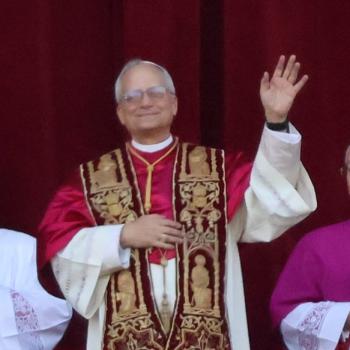Today the Catholic Church celebrates the feast of San Juan Diego, the first indigenous saint of the Americas, whose canonization I attended in Mexico City with Pope St. John Paul the Great on July 31, 2002. Juan Diego has since been joined by St. Kateri Tekakwitha, canonized at St. Peter’s Basilica by Pope Benedict XVI in 2012, and the boy martyrs of Tlaxcala, Mexico, whom Pope Francis canonized at St. Peter’s in 2017. Earlier this week, on December 6, the feast of St. Nicholas of Myra, I learned about another native man on the path to sainthood – Servant of God, Nicholas Black Elk, a member of the Oglala Sioux tribe who became lay catechist.
Indigenous and indigenous-Christian culture and history tend not to be well-known. Indeed, until I began reading, researching, and writing about the Nahuas of central colonial Mexico in graduate school, I had a rudimentary knowledge of native people. Even after studying the Nahuas for two decades, my knowledge is limited, prompting my extensive research to recreate Juan Diego’s world for the children’s chapter book that I am writing for Ignatius Press; for a brief overview of Juan Diego and his visions of Our Lady of Guadalupe, please see my previous post.
Most renditions of the Guadalupe story that I’ve seen do not take into account the indigenous, historical, and geographical context of 1530s Mexico City and the Valley of Mexico. My book, Juan Diego and the Lady on the Hill, represents—as far as I know—the first attempt to really engage with the context of the Guadalupe story. I write from an indigenous rather than European perspective, highlighting the beauties of Nahuatl language and culture against the backdrop of the origins of Mexican Catholicism
Why do most renditions of the Guadalupe story not take into account the indigenous, historical, and geographical context? Probably because their (mostly Catholic) authors know very little about Nahua culture, meaning they are likely unaware of all the ways they are Europeanizing the story. What Catholics are aware of is what William Christian Jr. identifies as “the genre of apparition literature” in Apparitions in Late Medieval & Early Modern Spain (Princeton, 1981). He notes that Catholic apparition stories has three main components, with some variation: 1) they involve a marginalized figure or figures, lowly outsiders who may be new or not yet fully formed in their faith; 2) the Church hierarchy and/or local authorities do not believe the visionaries; 3) there is some sort of sign, perhaps the discovery of a buried statue, to confirm the veracity of the marginalized figure’s visions. This certainly applies to the Guadalupe story.
As a quick aside, William Christian Jr., has a wonderful and succinct essay, “Catholicisms,” in Martin Austin Nesvig’s edited collection, Local Religion in Colonial Mexico (U. of New Mexico Press, 2006), which discusses the layered customs of the Catholic Church and its absorption of local culture, outlining how “[l]ocal variation in Catholicism has its place in canon law.” This is very useful when thinking about Juan Diego and the origins of Mexican Catholicism, and I pair these two selections from Christian when I assign The Story of Guadalupe: Luis Laso de la Vega’s Huei tlamahuiçoltica of 1649 (ed. Stafford Poole, Lisa Sousa, and James Lockhart), which leads to a rich discussion with students.
What I see in a lot of Catholic renditions of the Guadalupe story is an attempt to understand it on familiar European Catholic terms, leading to a Europeanizing of the protagonist as a pious European Catholic, rather than as a pious indigenous Catholic, someone who absorbed Catholicism into his life, rather than vice versa. I also see anachronisms, not surprising if someone is writing without understanding the historical context.
My children and I enjoy watching saint videos, and so I will be using an animated story to illustrate some of the common anachronisms and Europeanizations of Juan Diego. As stated earlier, I do not believe writers are motivated by malice so much as write in ignorance. (btw, I showed the video to my children, ages 5, 7, and 9, and they recognized all the errors I’ve outlined below).
Example: Story of Guadalupe | Miracles of Mary | Episode 01 (8:40 min)
0:15 The narrator incorrectly identifies Juan Diego as “an elderly Mexican man,” rather than as an elderly indigenous man. Mexico didn’t exist, as such, in 1531; this story takes place in the early years of New Spain. Beyond that, native peoples cannot grow facial hair as Europeans do, yet here we see Juan Diego with a full beard and mustache, and a European-style haircut.
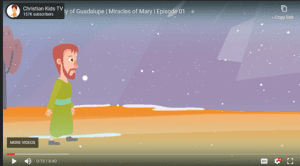
0:16 Artists have rendered Juan Diego in European clothes, maybe clothes from “Bible times” to signify his holiness? A macehualli (lower-class; plural macehualtin), Juan Diego would have worn an undyed maguey-fiber tilmatli (working-class cloak, rendered into modern Spanish as tilma) and a loincloth, nothing more. It’s unlikely he would have worn shoes, which were reserved for the native noble classes, though colonial rule might have bent the rules. In that case, he would have worn simple cactus-fiber sandals like the ones seen below, not closed-toed shoes.
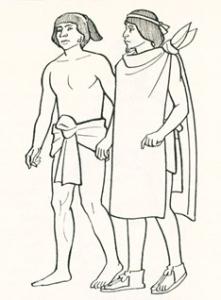
Mesoamerican maxtlatl (loincloth), tilmatli (cloak), cactli (footwear), and men’s hair.
0:18 Notice the white, steepled church (above). In colonial Mexico, native laborers built Christian churches from the rubble of their local teocalli (god-house); as I’ve mentioned elsewhere, historian James Lockhart has argued that native peoples viewed the Christian church as an analogue of the pre-contact temple, symbolizing their sovereignty and corporate identity and thus built the new sacred structures enthusiastically. They would have been the color of local stone, like the church built in the early sixteenth century at Tlatelolco in the image below, not a white steepled church from New England.
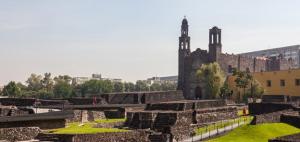 Ruins of the Colegio de Santa Cruz de Tlatelolco and the Franciscan friary and church
Ruins of the Colegio de Santa Cruz de Tlatelolco and the Franciscan friary and church
(Image: WIkimedia Commons)
0:21 The Franciscan friar would not have been dressed like a modern Roman Catholic priest. In 1531, he would likely be sporting a purple habit, since brown dye was difficult to produce in New Spain, but indigo was widely available; he would also have worn a three-knotted cord and rosary hanging from his waist. Beyond that, the altar would have been made of stone and attached to the wall.
0:30 The accounts I know do not mention daily Mass, but rather that it was Juan Diego’s custom to walk to Mass every Saturday, like this Saturday, December 9, 1531.
0:31 Inaccurate geographical setting – Mexico City is a desert landscape.
0:41 The animated Juan Diego speaks English in a Mexican accent, though as a commoner he would not have spoken Spanish, he would have spoken Nahuatl.
1:18 Was it snowing? The accounts indicate that the first apparition took place very early in the morning of December 9, 1531 when it was cold, before the sun had risen, but none of them mention snow. Also, it seems unlikely Juan Diego would “boulder climb” his way up Tepeyacac hill, which would have been covered in desert brush, not a steep granite face.
1:30 Part of the beauty of the story is that the Virgin Mary appears as a Nahua woman, pregnant with Christ, to a Nahua man, yet the animation portrays her as a European woman. As a Nahua woman, she would not have worn a European-style crown, but rather the richness of her clothing (colors and material), the fact that she wore shoes (not seen in the animation), and her elevated speech would have indicated her noble status to Juan Diego. Also, my understanding is that she appeared standing amidst the desert plants, not floating in the air.
1:35 “To him, she appeared as a native princess.” Princesses are European. To Juan Diego, she would have appeared as a Nahua noblewoman. That’s the point of the story – she appeared to a native man as a native woman to help her native people.
1:45 Although Nahua women (and goddesses) knelt and Nahua men (and gods) squatted, it makes sense to have Juan Diego kneeling, since he is Christianized, however, he likely also made the traditional Nahua sign of respect, the “earth-eating gesture,” bending forward as if to scoop up the earth and touch it to his lips, called tlalqualiztli in Nahuatl. After all, he had been a Nahua for 57 years (his traditional age at the time of the apparitions), and had only been Christian for a few years. Plus, I like to think that the Virgin, who appeared as a Nahua, would have understood, and appreciated, the gesture.
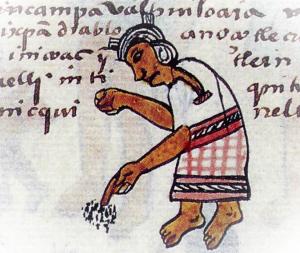
A Nahua woman symbolically eating earth; Primeros Memoriales, fol. 254v
2:13 The animated Virgin asks for a “shrine,” whereas in the accounts that we have, she asks for a teocalli (god-house), more of a small chapel rather than a large shrine, so that she might hear the cries of her people, and offer them her maternal love.
2:24-2:31 The animation shows Juan Diego walking to speak to the bishop in Mexico City, traversing flat, dry land. As I discussed in a previous post, the Mexica built Mexico-Tenochtitlan on an island, and the only way to get there in 1531 was to walk along the causeways over Lake Texcoco and then take the footpaths alongside the canals.
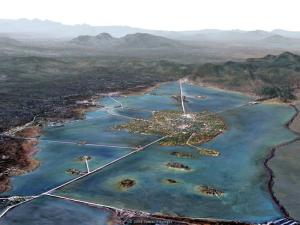
Artist’s rendition of the landscape surrounding Tenochtitlan and the causeways connecting it with the mainland, over which Juan Diego would have had to walk to reach the bishop
(www.mexicolore.co.uk)
Artist’s rendition of part of the canal network in Tenochtitlan; the squiggly lines indicate water and the footprints indicate walking paths
(www.mexicolore.co.uk)
2:32 Though it’s likely that some of the men assisting the bishop were indigenous aides, all of the animated men in the room are European. In addition, the bishop, fray Juan de Zumárraga, OFM, would have been dressed as a Franciscan, as I outlined in 0:21 above, and as a recent arrival, would not yet have been fluent in Nahuatl, so he would have spoken to Juan Diego via an interpreter.
3:52 According to the Nahuatl version of the story, Juan Diego asks the bishop what kind of a sign he would like and the bishop said the Lady would know. We don’t see that here.
3:55 The scene with Juan Diego in the home of his sick uncle, Juan Bernardino, has several problems. 1) Nahuas sleep on a petlatl, a reed mat, on the floor, not on an elevated wooden platform; 2) native peoples do not go white; familiar with the Dance of the Little Old Men in Michoacan, Mexico? That is the native way of poking fun at the Castilians for going gray; 3) native people don’t grow European-style facial hair, much less white facial hair; 4) native people do not generally go bald; 5) Nahua homes would be made of adobe, not stone
4:58 The vision where Juan Diego received the sign is the most important. According to the Nahuatl version of the story, when Juan Diego goes for a friar to give Last Rites to his uncle, he tries in vain to avoid the Virgin, “she who sees absolutely everywhere,” by walking behind Tepeyacac hill, yet she finds him on the path and they have a very polite, very Nahua exchange. She assures him that his uncle Juan Bernardino will be fine, then asks him to gather flowers growing on the hillside and bring them to her, arranging them in his tilmatli with her own hands (my favorite part of the story!) and asking him not to show anyone. For some reason, the animators move that encounter to just outside the bishop’s residence and have Juan Diego “mountain climb” up a hill.
6:25 “He plucked the flowers and carefully placed them in a piece of cloth he was carrying.” Uh, no, he placed the flowers in the tilmatli he was wearing, not a random piece of cloth. The tilmatli is indigenous clothing particular to his class that could be employed as an apron. It was part of his very identity.
6:36 Juan Diego would not have been carrying the flowers on his back like Santa Claus. He would have cradled them in his arms, as the Lady has instructed him, wrapped in his tilmatli.
6:59 The animated story has Juan Diego toss the flowers and the cloth with the image of the Virgin Mary onto the floor(!). Not only is this nowhere in the accounts I’ve read, but to have Juan Diego, a Nahua Christian, hurl a holy image onto the ground is baffling. Juan Diego’s tilmatli is an essential part of the story, today preserved in the Basilica of Our Lady of Guadalupe in Mexico City. It’s unclear why the writers would not include it, except that to use the tilmatli would force them to un-Europeanize the story, as it were, by dressing the characters in historically appropriate clothing. By not using the tilmatli, we lose the symbolism of Juan Diego wearing an image of the noble Nahua Lady he had seen on the hill and her “standing” between him and the colonial Europeans, as his heavenly protector. Again, the tilmatli was part of Juan Diego’s very identity as a macehualli (commoner).
7:21 “She looked like a native princess.” See 1:35 above.
7:44 “Juan returned from the bishop’s house. He was very happy now because everyone believed him.” According to the accounts we have, Juan Diego would not have been happy simply because the bishop believed him, but because the Virgin was going to get her teocalli to hear the cries of her native people, to assist those who were suffering under the cruelties of Spanish colonial rule.
8:00 None of the accounts I’ve read have the Lady ask Juan to collect all the flowers on his way home.
8:23 The word “Guadalupe” would have been unpronounceable in Nahuatl; scholars debate about whether the Lady used a Nahuatl word that the Castilians interpreted as Guadalupe, which is a holy site in Spain with an image of the Virgin. Then there are scholars who do not believe this story took place at all.
The Harm of europeanizing the Guadalupe Story
Why is it harmful to represent the Guadalupe story in a Eurocentric format? This is what I ask my students after we read the texts I mentioned above and watch and dissect this video. We discuss how Europeanizing the story lessens its power. This is the story of a native woman appearing to a native man to express her love for her suffering native children. And who is causing their suffering? European men, mostly from Castile, most of whom were culturally Catholic in a way typical of Early Modern Iberia, men who did not see their actions as incompatible with their faith. Europeanizing the story usurps the story, taking away an important part of indigenous-Catholic identity in Mexico, by altering and effacing its native protagonists. This is why I feel blessed to be writing a book that presents Juan Diego’s visions as the indigenous story that it is.
Of course, there are scholars who argue that the story isn’t indigenous at all, but rather a creole invention dating to the middle of the colonial period, when locally-born Castilians (criollos) desired to rule themselves, rather than submit to rule from peninsulares (Castilians born in the peninsula). Perhaps that’s a discussion best left for another time.
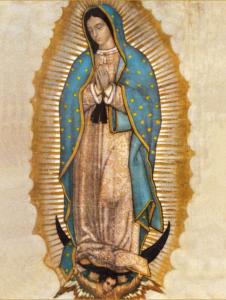
Juan Diego’s tilmatli as preserved in the Basilica of Our Lady of Guadalupe in Mexico City


